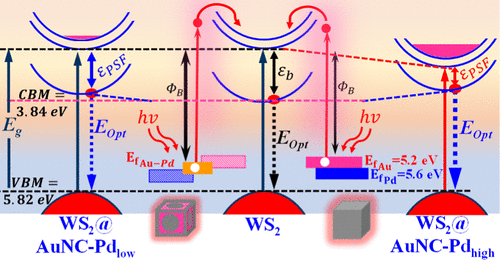Our official English website, www.x-mol.net, welcomes your
feedback! (Note: you will need to create a separate account there.)
Tuning the Optical Band Gap of Two-Dimensional WS2 Integrated with Gold Nanocubes by Introducing Palladium Nanostructures
Langmuir ( IF 3.7 ) Pub Date : 2021-09-02 , DOI: 10.1021/acs.langmuir.1c01307 Chih-Kai Liao 1 , Guanhua Wu 1 , Mahmoud A Mahmoud 1, 2, 3
Langmuir ( IF 3.7 ) Pub Date : 2021-09-02 , DOI: 10.1021/acs.langmuir.1c01307 Chih-Kai Liao 1 , Guanhua Wu 1 , Mahmoud A Mahmoud 1, 2, 3
Affiliation

|
The two characteristic absorption peaks of semiconducting two-dimensional tungsten disulfide (WS2) are red-shifted after integrating with gold nanocube (AuNC) arrays. The amount of the red shift is reduced when the AuNCs are coated with a high concentration of Pd. A negligible shift was observed in the absorption peaks of WS2 when smaller amounts of Pd are introduced to the surface of AuNCs. Conversely, the photoluminescence (PL) of WS2 is blue-shifted when measured on top of AuNCs and AuNCs coated with different amounts of Pd. AuNC–Pd Janus nanoparticles are prepared by depositing Pd atoms asymmetrically on AuNCs assembled into 2-D arrays on the surface of a glass substrate by the chemical reduction of Pd ions. Due to the large AuNC or AuNC–Pd/WS2 Schottky barrier, the plasmon-induced hot electron transfer (PHET) from AuNCs and AuNCs coated with a high concentration of Pd is responsible for the red shift of the absorption spectrum of WS2. Introducing a lower concentration of Pd to AuNCs increases the Schottky barrier further due to the formation of the Au–Pd equilibrium Fermi level of lower energy, reducing the efficiency of PHET. The effect of Pd on the Fermi level of AuNCs vanishes at high Pd deposition. Pauli blocking and phase-space filling are responsible for the blue shift of PL of WS2 on top of AuNCs and AuNCs coated with Pd. The Pauli blocking effect is directly proportional to the PHET efficiency. This explains the significant blue shift of PL of WS2 after integrating with AuNCs and AuNCs coated with a high concentration of Pd. Additionally, depositing Pd onto AuNCs elongates the lifetime of the hot electrons and enhances the PHET efficiency.
中文翻译:

通过引入钯纳米结构调整与金纳米立方体集成的二维 WS2 的光学带隙
半导体二维二硫化钨(WS 2)的两个特征吸收峰在与金纳米立方体(AuNC)阵列集成后发生红移。当 AuNCs 涂有高浓度的 Pd 时,红移量会减少。当少量的 Pd 被引入到 AuNCs 的表面时,WS 2的吸收峰的变化可以忽略不计。相反,当在 AuNCs 和涂有不同量 Pd 的 AuNCs 顶部测量时,WS 2的光致发光 (PL) 发生蓝移。AuNC-Pd Janus 纳米粒子是通过将 Pd 原子不对称地沉积在 AuNCs 上制备的,AuNCs 通过 Pd 离子的化学还原在玻璃基板表面组装成二维阵列。由于大的 AuNC 或 AuNC–Pd/WS2肖特基势垒中,来自 AuNC 和高浓度 Pd 涂层的 AuNC 的等离子体诱导热电子转移 (PHET) 是 WS 2吸收光谱红移的原因。由于形成了较低能量的 Au-Pd 平衡费米能级,将较低浓度的 Pd 引入 AuNCs 进一步增加了肖特基势垒,从而降低了 PHET 的效率。Pd 对 AuNCs 费米能级的影响在高 Pd 沉积时消失。泡利阻塞和相空间填充是导致 WS 2在 AuNCs 和涂有 Pd 的 AuNCs 顶部的PL 蓝移的原因。泡利阻塞效应与 PHET 效率成正比。这解释了 WS 2 PL 的显着蓝移与 AuNCs 和 AuNCs 结合后,涂有高浓度的 Pd。此外,将 Pd 沉积到 AuNC 上可延长热电子的寿命并提高 PHET 效率。
更新日期:2021-09-14
中文翻译:

通过引入钯纳米结构调整与金纳米立方体集成的二维 WS2 的光学带隙
半导体二维二硫化钨(WS 2)的两个特征吸收峰在与金纳米立方体(AuNC)阵列集成后发生红移。当 AuNCs 涂有高浓度的 Pd 时,红移量会减少。当少量的 Pd 被引入到 AuNCs 的表面时,WS 2的吸收峰的变化可以忽略不计。相反,当在 AuNCs 和涂有不同量 Pd 的 AuNCs 顶部测量时,WS 2的光致发光 (PL) 发生蓝移。AuNC-Pd Janus 纳米粒子是通过将 Pd 原子不对称地沉积在 AuNCs 上制备的,AuNCs 通过 Pd 离子的化学还原在玻璃基板表面组装成二维阵列。由于大的 AuNC 或 AuNC–Pd/WS2肖特基势垒中,来自 AuNC 和高浓度 Pd 涂层的 AuNC 的等离子体诱导热电子转移 (PHET) 是 WS 2吸收光谱红移的原因。由于形成了较低能量的 Au-Pd 平衡费米能级,将较低浓度的 Pd 引入 AuNCs 进一步增加了肖特基势垒,从而降低了 PHET 的效率。Pd 对 AuNCs 费米能级的影响在高 Pd 沉积时消失。泡利阻塞和相空间填充是导致 WS 2在 AuNCs 和涂有 Pd 的 AuNCs 顶部的PL 蓝移的原因。泡利阻塞效应与 PHET 效率成正比。这解释了 WS 2 PL 的显着蓝移与 AuNCs 和 AuNCs 结合后,涂有高浓度的 Pd。此外,将 Pd 沉积到 AuNC 上可延长热电子的寿命并提高 PHET 效率。











































 京公网安备 11010802027423号
京公网安备 11010802027423号